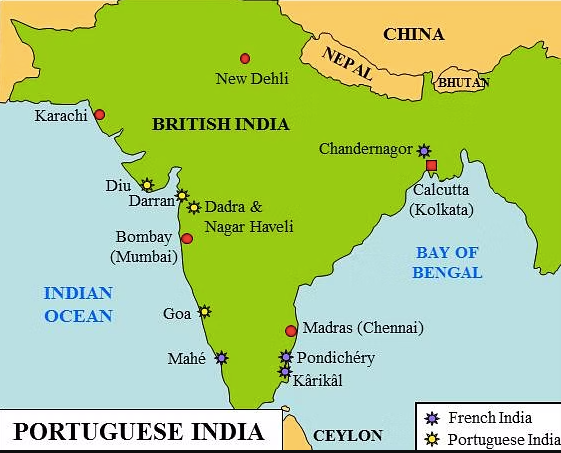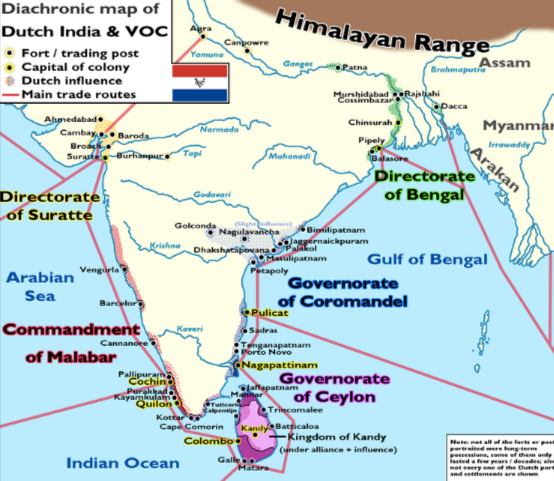British / Europen Advent in India:
India had contact with Europe from time immemorial through land route ( silk route). The discovery of the silk route had far-reaching consequences on the shape and course of Indian history.
The first traders to arrive in India were Portugues (1498). They were followed by British > Dutch > Danes > French.
In these 450 years, a lot of changes happened in India. India has changed from a feudal, conservative, exclusive social system to a capitalistic, progressive and inclusive, social system with self-assertion based on introspection and external stimuli of ideas such as equality, liberty, fraternity, and people’s rule instead of one man’s rule.
Portugues in India:
- Prince Henry Navigator: Ruler of Portugal took the lead among European nations and promoted sea fairing activities.
- The spirit of adventure that led to the foundation of the modern world promoted geographical discoveries in far-flung areas. The primary objective of Vovyage was earning profit from trade with eastern countries.
- During the regime of Kim John 2nd: Bartholomew Diaz crossed the Cape of Good Hope, he was the sea fairer. This particular event gave great impetus to European sea fairers.
- During the regime of King Vasco de ga ma reached the coast of Calicut in May 1498, Zamorin of Kerala warmly received him.
- Vascodegama again came back to India in 1501 and returned in 1503 by the time he established a trading centre in Calicut, coaching and Kannur.
- De Almeida was appointed the first Portuguese viceroy in India, he affected the blue water policy to control the entire trade route of the Indian Ocean and the Arabian Sea.
- Albuquerque in 1905 was appointed next Viceroy he was considered goa in 1501 and created a fort at Cochin. He also covered Hormuz in the Persian Gulf and eclipsed the influence of Arab traders in India.
- He also built a fort at coachin’ with the permission of local rulers.
- Ninu da Cunha the last viceroy acquired Due and Basian with the Gujrat ruler Bahadur Shah in 1534- 1538.

Portuguese impact on India :
- Promotion of cash crops in India like Cotton, silk, spices and tobacco.
Dutch East India Company in India:
1 It was established on 20th March 1602 as a chartered company to trade with Mughal India.
2 Dutch were mainly interested in the spice trade.
3 They opened factories at Pulicut, Cambay, Agra, Surat, Harcharpur Patna, Dacca, Nagapattinam, and Qasim Bazar Bengal.
4. They faced stiff competition from the British and Portuguese.
5 They also had a monopoly over trade over Indonesia Island which is why they left India.

Danish East India Company
1 Established in 1616. Trading outpost at Tranquebar Tamil Nadu.
2 Promoted Christian missionary activities in India, and made Serampur the hub of missionary activities.
3 Danish officer William Reverand established a Printing press in 1799 to publish the Bible at Serumpur.
4 In 1845, Denmark ceded serampur to British
British/ East India Company
The English Association of Merchant Adventures was to carry on trade with the East.
2, On 31st Dec 1600 Queen Elizabeth gave a royal chatter of 1500 years to Merchant.
3, Over the period the British company popularly known as East India Company.
4 In the beginning a British envoy led by Sir William Hawkins came to the court of Jahangir, he received some concessions from Jahangir
5. He was also granted Mansab status. But under the pressure of nobles of the Mughul court, Jahangir revoked the concession
6. By the time, Britishers were complete with the construction of warehouses at Surat and Masulipatnam.
7. In 1615, another Voyage under Sir Thomas Roe came to Jahangir’s court and granted him further concessions.
8. The British established factories at Agra, Ahmedabad and Baroch.
9 In 1639, the British got some villages around Madras on lease where they created St. Fort George.
10 In 1616, there was a matrimonial alliance between the Portuguese prince and Prince Charles 2nd of Britain.
11. In 1668, Bombay was transferred to EIC at a nominal price of 10 pounds then Bombay became the trading headquarters from Madras.
12. In 1698, they acquired villages on a lease, Sutanati and Kalikatta, where constructed St fort William.
French East India Company.
1 It was the last European company established in 1664.
2. It was a state-controlled company But EIC was a private entity.
3, Moreover, from 1723 onward, the French EIC was completely controlled by the French govt.
4. They established their ist factory at Surat in 1688, Masulipatnam in 1669, Pondicherry in 1673, and Chandranagar in 1692.
5. Soon after the arrival of the French EIC, the rivalry between the French and the British started to emerge.
6 With the appointment of French governor Joseph Francose Duplex in 1740, The British- French rivalry was further aggravated.
7. It was the French who started the policy of interfering in the internal politics of the Indian kingdom, later followed by the Britishers and also they mastered it better.
MCQS ASKED DOWN THE YEAR
- Which European power was the first to arrive in India for trade?
- A) British
- B) Dutch
- C) Portuguese
- D) French
- The Battle of Plassey, which marked the beginning of British colonial rule in India, was fought in which year?
- A) 1747
- B) 1757
- C) 1764
- D) 1773
- Which treaty marked the end of the First Anglo-French War in India?
- A) Treaty of Pondicherry
- B) Treaty of Madras
- C) Treaty of Paris
- D) Treaty of Aix-la-Chapelle
- Who among the following was the Governor-General of India during the signing of the Treaty of Allahabad?
- A) Robert Clive
- B) Warren Hastings
- C) Lord Cornwallis
- D) Lord Wellesley
- Which city was the first trading post established by the British in India?
- A) Surat
- B) Bombay
- C) Madras
- D) Calcutta
- The ‘Dual Government’ system in Bengal was introduced by which British official?
- A) Robert Clive
- B) Warren Hastings
- C) Lord Cornwallis
- D) Lord Wellesley
- Which of the following statements about the French colonial ventures in India is correct?
- A) They established their first factory at Machilipatnam.
- B) They were more focused on commercial trade than political control.
- C) The French East India Company was founded before the British East India Company.
- D) The French never had control over any territories in India.
- Which European power was defeated by the British in the Battle of Wandiwash?
- A) Portuguese
- B) Dutch
- C) French
- D) Danish
https://unacademy.com/content/upsc/study-material/modern-indian-history/first-arrival-of-east-india-company
https://testbook.com/objective-questions/mcq-on-rise-of-east-india-company–5eea6a1239140f30f369ed6b
The first Europeans to arrive in India using the sea route was?
A. Vasco da Gama
B. Selukas Niketar
C. Columbus
D. Zamorin
Answer with detailed explanation
Q 2. The English East India Company was established in the year ?
A. 1600
B. 1608
C. 1613
D. 1664
Answer with detailed explanation
Q 3. Who among the following is regarded as the real founder of the Portuguese colonial empire in India ?
A. Vasco da Gama
B. Francisco de Almeida
C. Columbus
D. Afonso de Albuquerque
Answer with detailed explanation
Q 4. Who among the following was the last East India company to be formed ?
A. British East India Company
B. Dutch East India Company
C. Portuguese East India Company
D. French East India Company
Answer with detailed explanation
Q 5. Joseph Francois Dupleix belonged to ?
A. British East India Company
B. Dutch East India Company
C. Portuguese East India Company
D. French East India Company
Answer with detailed explanation
Q 6. English East India Company established their first factory in ?
A. Goa
B. Surat
C. Bombay
D. Masulipatnam
Answer with detailed explanation
Q 7. Fort Saint George, the first fort built by the British in India was located at ?
A. Goa
B. Kolkata
C. Bombay
D. Madras
Answer with detailed explanation
Q 8. The privileges of free trade rights were granted to the English East India Company in 1717 by the Mughal Emperor ?
A. Bahadur Shah
B. Shahjahan
C. Jahangir
D. Farrukh-Siyar
Q 9. Bombay was handed over to East India Company by ?
A. Portuguese
B. Charles II
C. Jahangir
D. French
/https://civilscracker.com/arrival-of-europeans-in-india-mcqs/
Q 10. The peace treaty of ‘Aix-la-Chapelle’ was signed between the British and?
A. Portuguese
B. Mughals
C. Dutches
D. French
Follow Facebook) https://www.facebook.com/profile.php?id=61557200638719